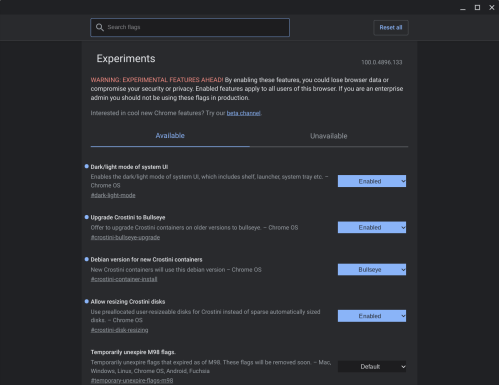In an earlier post I wrote about my frustration of trying to update a Chromebook Linux container from Debian 10/Buster to Debian 11/Bullseye. No matter how many fora messages I checked or how many how-to or technical blog postings I read, absolutely none of them worked. Then one evening, while looking at Chrome’s chrome://flags, I discovered an important setting (I’m writing about Version 100.0.4896.133).

Figure 1 shows what my Chrome flags are set to. The critical flag is “Debian version for new Crostini containers.” Mine is deliberately set by me to Bullseye, or Debian 11. If it’s left to Default then it will be Debian 10. I took a second Lenovo Chromebook I have, set that flag, deleted the existing Debian 10 container, and then created a new container. Sure enough when I opened the container’s terminal and checked I was running Debian 11.
Right after this I updated Debian 11 to make sure I had all the latest software. Rather than wipe and reload on my primary Chromebook, I’m going to turn on another flag, “Allow multiple Chrostini containers,” and create a second container running Debian 11. If that works then I’ll try to “migrate” from my existing Debian 10 container over to my new Debian 11 container, then delete the Debian 10 container. Or maybe just keep both. I don’t know at this point.
For the future, at least for me, I’ll set the container Debian version explicitly up to the highest level allowed before I create a Debian Linux container.
Update 3 May
I went looking for a way to create a second Debian Linux container and couldn’t find anything. So I guess I won’t be doing that. That leaves the re-create the container method as the only viable method to date.


You must be logged in to post a comment.